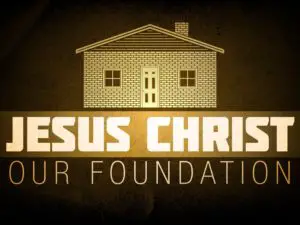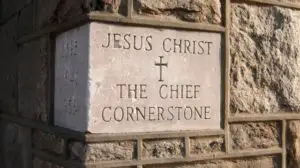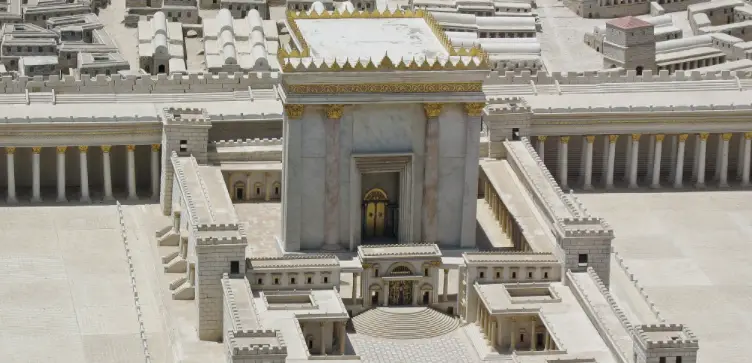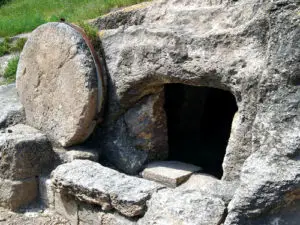Scripture uses a variety of metaphors to illustrate spiritual truths. For example, the Church is described as a building. Paul used this analogy in his first letter to the church in Corinth:
1 Corinthians 3:5 and 9-11 (NASB) What then is Apollos? And what is Paul? Servants through whom you believed, even as the Lord gave opportunity to each one… 9 For we are God’s fellow workers; you are God’s field, God’s building. 10 According to the grace of God which was given to me, like a wise master builder I laid a foundation, and another is building on it. But each man must be careful how he builds on it. 11 For no man can lay a foundation other than the one which is laid, which is Jesus Christ. (emphasis added)
The apostle goes on to say that he, Apollos, and others were co-laboring with God to build the Corinthian believers into a temple for God’s habitation:
1 Corinthians 3:16-17 (NASB) Do you not know that you are a temple of God and that the Spirit of God dwells in you? 17 If any man destroys the temple of God, God will destroy him, for the temple of God is holy, and that is what you are. (emphasis added)
Jesus Christ, the Foundation of the Church
Of particular interest is the fact that the foundation that Paul laid in Corinth, as a wise master builder, was the teaching that Jesus is the Christ. The apostle cautioned that this truth is the only foundation upon which we can build.[1]

Luke, who was Paul’s companion on his missionary trip, offers this summary of their time spent in the metropolis by the sea:
Acts 18:1 and 5-8 (NASB) After these things he left Athens and went to Corinth. 5 But when Silas and Timothy came down from Macedonia, Paul began devoting himself completely to the word, solemnly testifying to the Jews that Jesus was the Christ. 6 But when they resisted and blasphemed, he shook out his garments and said to them, “Your blood be on your own heads! I am clean. From now on I will go to the Gentiles.” 7 Then he left there and went to the house of a man named Titius Justus, a worshiper of God, whose house was next to the synagogue. 8 Crispus, the leader of the synagogue, believed in the Lord with all his household, and many of the Corinthians when they heard were believing and being baptized. (emphasis added)
What did the Corinthians believe? According to the context, they believed Paul’s message that Jesus was the Christ. It’s important to note that Paul did not preach that Jesus was the God-Man or the second member of a multi-person deity. Rather, the former Pharisee testified that Jesus was the Messiah, which means the anointed one of God, the promised king.
Paul isn’t the only one who taught that Jesus’ identity as the Christ was the foundation of the Church. Jesus taught this as well:
Matthew 16:15-18 (NASB) He *said to them, “But who do you say that I am?” 16 Simon Peter answered, “You are the Christ, the Son of the living God.” 17 And Jesus said to him, “Blessed are you, Simon Barjona, because flesh and blood did not reveal this to you, but My Father who is in heaven. 18 “I also say to you that you are Peter, and upon this rock I will build My church; and the gates of Hades will not overpower it. (emphasis added)
God the Father revealed to Peter that Jesus is the Christ, a term synonymous with Son of the living God. Jesus declared that this truth would be the rock or foundation upon which he would build his Church. Take note, once again, that the foundation upon which the Church was to be built did not include a teaching on Jesus’ supposed incarnation or membership in a tri-part Godhead. Rather, it was upon the revelation that Jesus is the anointed one of God.
Jesus Christ, the Chief Cornerstone
Paul used the building metaphor again in his letter to the Ephesians:
Ephesians 2:19-22 (NASB) So then you are no longer strangers and aliens, but you are fellow citizens with the saints, and are of God’s household, 20 having been built on the foundation of the apostles and prophets, Christ Jesus Himself being the corner stone, 21 in whom the whole building, being fitted together, is growing into a holy temple in the Lord, 22 in whom you also are being built together into a dwelling of God in the Spirit. (emphasis added)
Paul explained to the church in Ephesus that they were fellow citizens with the saints because their relationship with God (they were a part of His household) was built upon the foundation or teaching of the apostles and prophets. We’ve already learned that the foundation was the revelation that Jesus is the Christ.

Paul elaborates on the building metaphor by proclaiming Jesus to be the cornerstone of the temple in which God dwells in the Spirit. Just as God’s Spirit filled the temple constructed by Solomon,[2] God now fills the spiritual temple which consists of believers with Jesus being the chief cornerstone.
The cornerstone, or chief cornerstone as it was also called, was an architectural term that referred to the first stone laid in a building. It was the most crucial element in the construction process as its placement would determine the soundness of the structure since all other stones would be placed according to its positioning. Only those who are aligned, so to speak, with Jesus, the chief cornerstone, are a part of God’s temple.
It is crucial that we understand that Jesus is described as a part of this spiritual structure in which God dwells. Albeit the most important part, but a part nevertheless. While God, on the other hand, is the one who occupies the building. In other words, the temple is not for Jesus, but for the God of Jesus, as Paul often refers to Him.[3]
Peter also describes Jesus Christ as the cornerstone. He uses the building analogy to explain Jesus’ role or function in this supernatural building called the Church. For example, when Peter was arrested and brought before the Sanhedrin, he used the building metaphor in his Spirit-filled response to the council:
Acts 4:8-12 (NASB) Then Peter, filled with the Holy Spirit, said to them, “Rulers and elders of the people, 9 if we are on trial today for a benefit done to a sick man, as to how this man has been made well, 10 let it be known to all of you and to all the people of Israel, that by the name of Jesus Christ the Nazarene, whom you crucified, whom God raised from the dead—by this name this man stands here before you in good health. 11 “He is the STONE WHICH WAS REJECTED by you, THE BUILDERS, but WHICH BECAME THE CHIEF CORNER stone. 12 “And there is salvation in no one else; for there is no other name under heaven that has been given among men by which we must be saved.” (emphasis added)
Peter applies a prophetic word from Psalm 118 to the man from Nazareth.[4] Jesus is the stone that the Jewish leaders rejected, but which became the chief cornerstone, that is, the Christ. Furthermore, Peter emphasizes that Jesus’ name, which was given to him by God,[5] is the only means by which we can come into a relationship with God. Or, to put it another way, Jesus is the only way we can become a part of the Church, God’s dwelling place.
Peter further elaborates on this theme and its spiritual application in his first epistle:
1 Peter 2:4-8 (NASB) And coming to Him as to a living stone which has been rejected by men, but is choice and precious in the sight of God, 5 you also, as living stones, are being built up as a spiritual house for a holy priesthood, to offer up spiritual sacrifices acceptable to God through Jesus Christ. 6 For this is contained in Scripture: “BEHOLD, I LAY IN ZION A CHOICE STONE, A PRECIOUS CORNER stone, AND HE WHO BELIEVES IN HIM WILL NOT BE DISAPPOINTED.” 7 This precious value, then, is for you who believe; but for those who disbelieve, “THE STONE WHICH THE BUILDERS REJECTED, THIS BECAME THE VERY CORNER stone,” 8 and, “A STONE OF STUMBLING AND A ROCK OF OFFENSE“; for they stumble because they are disobedient to the word, and to this doom they were also appointed. (emphasis added)
It’s important to see that Peter, like Paul, designates Jesus as an element in God’s spiritual house. He is a living stone, indeed the choice stone, but a stone nevertheless, among other living stones.
Jesus, the Apostle and High Priest in God’s House
Peter also says that as living stones, we are being built up as a spiritual house for a holy priesthood to offer up spiritual sacrifices to God. Not to God and Jesus, but to God through Jesus. The man from Nazareth is designated as a priest as well. It was God, in fact, who appointed him to this role:
Hebrews 3:1-6 (NASB) Therefore, holy brethren, partakers of a heavenly calling, consider Jesus, the Apostle and High Priest of our confession; 2 He was faithful to Him who appointed Him, as Moses also was in all His house. 3 For He has been counted worthy of more glory than Moses, by just so much as the builder of the house has more honor than the house. 4 For every house is built by someone, but the builder of all things is God. 5 Now Moses was faithful in all His house as a servant, for a testimony of those things which were to be spoken later; 6 but Christ was faithful as a Son over His house—whose house we are, if we hold fast our confidence and the boast of our hope firm until the end. (emphasis added)
The Old Testament examples of Aaron and his descendants help us understand that a high priest does not receive sacrifices for himself, but is the mediator through whom sacrifices are offered to God. Jesus was appointed as God’s High Priest in God’s temple to mediate between God and man.
1 Timothy 2:5 (NASB) For there is one God, and one mediator also between God and men, the man Christ Jesus (emphasis added)
While God, Jesus and believers are said to be participants in the building of the Church, only Jesus and believers are said to be a part of the structure. God is never described as being a part of His own temple. On the contrary, He is the one who inhabits the spiritual household of believers. Which begs the question, if Jesus is God, as orthodoxy claims, why isn’t the temple his dwelling place, as well? Why is he referred to as a stone in the temple, but not the one who inhabits the temple? The answer: Jesus is not God.
This may come as a surprise to many who have been taught that Jesus is co-equal and con-substantial with God the Father. If that were the case, then we would rightly expect Jesus to occupy the temple and to receive sacrifices and offerings. Instead, Jesus is a priest, indeed the high priest, who, along with the priesthood of believers, ministers to God.
The foundation of the Church and the cornerstone of God’s temple, no longer resemble the Christ of the first century. Tragically, the Church fathers read the Jewish Scriptures through a Greek philosophical lens. Over a period of 350 years, they recast the foundation and chiseled the cornerstone to the extent that Jesus was reshaped into God. Such a seismic shift must be corrected if we are to take Paul’s instruction to heart:
1 Corinthians 3:11 (NASB) For no man can lay a foundation other than the one which is laid, which is Jesus Christ. (emphasis added)
It is time for the Church to reestablish itself upon its true foundation, that is, Jesus as the Christ of God.



